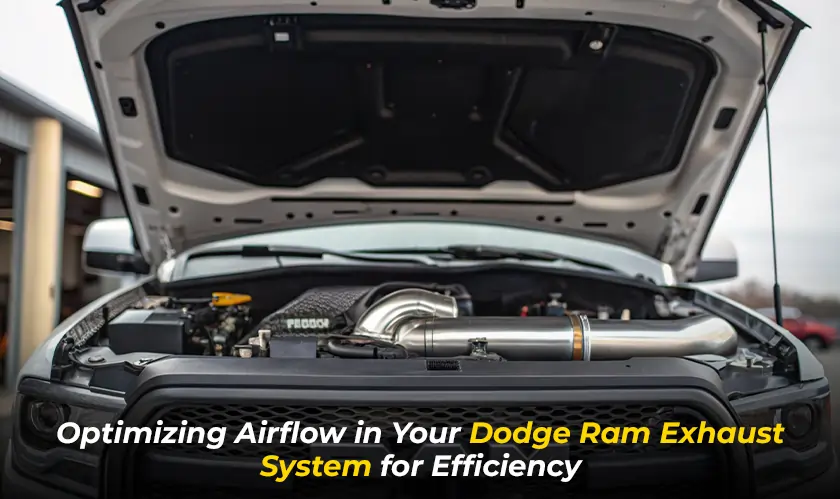Home Industry Automobile Optimizing Airflow in Your Dod...
Automobile

CIO Bulletin
24 March, 2025
Trucks like the Dodge Ram aren’t just about getting from point A to B—they’re built for hauling, off-roading, and turning heads. Whether it’s for work or weekend adventures, Ram owners take pride in performance. But while the engine and tires usually get all the attention, one upgrade often flies under the radar: the exhaust system.
A well-tuned exhaust setup can change the way your truck feels on the road. It helps your engine breathe better, run stronger, and burn fuel more efficiently. If you’ve been chasing more power or wondering why your mileage is slipping, your exhaust might be the hidden culprit.
Factory exhaust systems are designed to meet basic standards, not maximize performance. In Dodge Ram 1500 trucks, especially models with the popular 5.7L HEMI or 6.2L Supercharged HEMI engines, the stock Dodge Ram exhaust system tends to choke the engine a bit. The pipes are often narrower than they need to be, which creates backpressure.
This setup keeps noise down and cuts costs for the manufacturer, but it also limits what the engine can do. If you’ve ever felt like your truck isn’t pulling as hard as it should or wondered why your gas mileage dropped, the factory exhaust could be part of the problem. Doing regular checks on these parts can help spot clogs or corrosion before they turn into serious performance issues.
Upgrading to high-flow components is one of the quickest ways to wake up your Ram’s performance. Replacing narrow, restrictive stock parts with mandrel-bent pipes (which maintain a consistent diameter), performance mufflers, and high-flow catalytic converters allows exhaust gases to exit faster and more smoothly. That means less backpressure, more torque, and better fuel economy.
Some drivers notice the difference immediately—quicker throttle response, a deeper growl, and even improved mileage. For those looking to take things further, aftermarket headers or a true dual exhaust setup can deliver even more gains by improving scavenging and helping the engine cycle air more efficiently from the first stroke.
How your exhaust system is routed makes a big difference in how well it performs. A straighter pipe layout with fewer bends makes it easier for exhaust gases to flow. The more twists and turns there are, the more likely it is to slow things down. Shorter, straighter runs are better whenever possible.
Exit placement is another small detail that matters. Where the exhaust exits the truck can change how well gases leave the system. If they can’t escape easily, it creates extra pressure in the system. You can also help things along by paying attention to underbody airflow. Adding heat shields and insulation helps manage temperatures and prevents heat soak. Lightweight materials work best since they add less weight and do the job well.
Backpressure is a tricky thing. You need just the right amount. Too much, and you lose power. Too little, and you can hurt your low-end torque, especially in a heavy-duty truck like the Ram 1500. The goal is to let the exhaust out easily without killing the engine’s ability to breathe at low RPMs.
This balance can be found by using pipes that are the right size for your engine and removing overly restrictive parts. A good backpressure gauge can help you see what’s really going on in your system. Making small adjustments based on real data keeps your truck running strong without burning extra fuel or feeling sluggish.
Even the best exhaust setup won’t last if you don’t take care of it. Regular inspections for rust, leaks, and loose connections will keep things running right. Rust can eat through pipes, causing leaks that mess with airflow and cost you power. Tight seals and good clamps—like stainless steel T-bolt clamps—can make a noticeable difference in keeping the system airtight and vibration-resistant.
Oxygen sensors and catalytic converters need attention too. If they’re not working properly, they can throw off your fuel mixture and lead to poor performance or higher emissions. Replacing these parts when needed keeps everything running smoothly.
Tuning up your Dodge Ram’s exhaust isn’t just about power—it’s about getting the most out of every drive. Swapping in better-flowing parts, simplifying the pipe layout, and staying on top of maintenance can transform how your truck feels on the road. Whether you’re towing, cruising, or heading off-road, these upgrades bring noticeable gains in fuel efficiency and performance. Don’t wait until issues show up. Start with a few smart changes, listen to how your Ram responds, and enjoy a smoother, stronger ride. Your exhaust system might just be the key to unlocking the truck you always knew was there.







